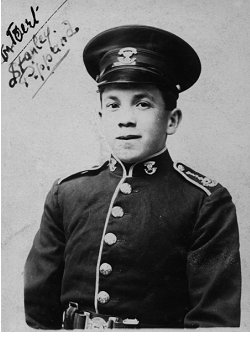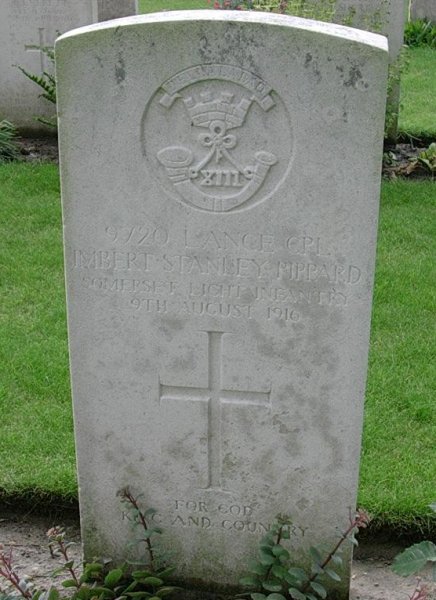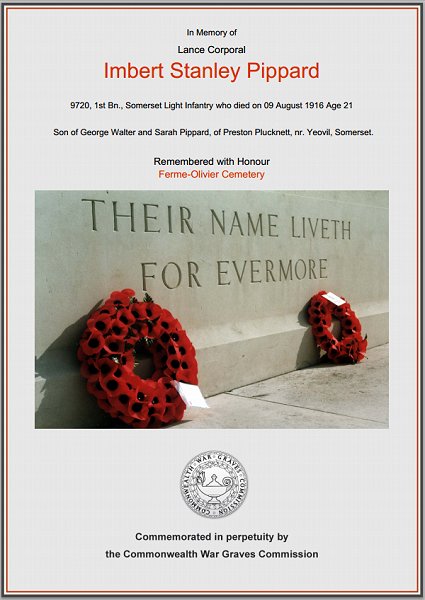yeovil at War
Imbert Stanley 'Bertie' Pippard
Died "from the effects of a Hun gas attack"
Imbert Stanley Pippard, known as Bertie, was born in Preston Plucknett, Yeovil, in 1894, the son of shoe maker and leather agent George Walter Pippard (1866-1942), from Islington, London, and dressmaker Sarah née Barnett (1867-1928) of Mudford.
The Pippards were originally a Montacute family, plasterers by trade for generations. George's father Paul, moved to London where his first wife and daughter died of tuberculosis in 1865. Paul remarried and had two children; George and Ellen. What happened later is a mystery but by 1870 the two children were in the Yeovil workhouse, the entry in the register is 'deserted by parents'. George was later apprenticed to a shoemaker, he did well and had his own business in Watercombe, Yeovil. (Many thanks to Patricia Jones for this paragraph).
Imbert was the fourth of eleven children. In the 1901 census the family, including 6-year old Imbert, were living in Watercombe. In the 1911 census the family were still living at Watercombe and Imbert, now 16, gave his occupation as 'Golf Club Assistant', and was employed as an assistant to the professional on the Yeovil and South Somerset Golf Links.
 In
March 1914
Bertie enlisted
at Yeovil in the
1st Battalion,
Somerset Light
Infantry as a
Regular soldier.
His Service
Number was 9720
and he was soon
promoted to
Lance-Corporal.
In
March 1914
Bertie enlisted
at Yeovil in the
1st Battalion,
Somerset Light
Infantry as a
Regular soldier.
His Service
Number was 9720
and he was soon
promoted to
Lance-Corporal.
At the outbreak of war in 1914 the 1st Battalion was in Colchester, with 11th Brigade, 4th Division. The Battalion landed at Le Havre, France with the British Expeditionary Force (BEF) on 22 August 1914 although Bertie didn't join his Battalion in France until 11 November 1914. The 1st Battalion, Somerset Light Infantry remained on the Western Front with 4th Division, throughout the war, suffering 1,315 losses and Bertie was to fight in several battles with his Battalion.
The Battle of Messines, fought between 12 October and 2 November 1914, was part of the 'Race to the Sea', the series of battles that decided the line of the Western Front. In the aftermath of the first Battle of the Marne, it was decided to move the BEF back north to Flanders, to shorten its supply lines back to the channel ports. The Battle of Messines was the official name for the fighting between the river Douve and the Comines-Ypres canal, but it merged into the battle of Armentières to the south and the first battle of Ypres to the north.
In 1915 the 1st Battalion, Somerset Light Infantry fought in the Second Battle of Ypres.
The Second Battle of Ypres, 22 April-25 May 1915, was a rare German offensive on the Western Front during 1915. It was launched with two aims in mind. The first was to distract attention from the movement of German troops to the eastern front in preparation for the campaign that would lead to the victory of Gorlice-Tarnow. The second was to assess the impact of poisoned gas on the western front. Gas had already been used on the eastern front, at Bolimov (3 January 1915), but the tear gas used there had frozen in the extreme cold. At Ypres the Germans used the first lethal gas of the war, chlorine. The gas was to be released from 6,000 cylinders and would rely on the wind to blow it over the allied trenches. This method of delivery controlled the timing of the attack – the prevailing winds on the western front came from the west, so the Germans had to wait for a suitable wind from the east to launch their attack. The line around Ypres was held by French, Canadian and British troops. The attack on 22 April hit the French lines worst and, not surprisingly, the line broke under the impact of this deadly new weapon. The gas created a gap 8,000 yards long in the Allied lines north of Ypres. The success of their gas had surprised the Germans who didn’t have the reserves to quickly exploit the unexpected breakthrough, allowing enough time to plug the gap with newly arrived Canadian troops. During the battle the British, French and Canadians suffered 60,000 casualties, the Germans only 35,000.
In 1916 the 1st Battalion moved south and were in action during the Battles of the Somme.
The Battle for the Somme has a unique place in British military history. Haig was in the middle of preparations for a British offensive but came under strong pressure to mount an attack due the French commitment to the Battle for Verdun, a city which held an important place in the nation's psyche and that the Germans had attacked in February 1916. Any Allied offensive would therefore have to be carried mainly by the British. Haig was therefore forced to undertake an offensive near to where the British and French lines met, near Bray-sur-Somme in Picardy, although he would have preferred to attack further north and to have had longer with which to prepare his new army. The battlefield was bisected by both the Albert – Bapaume Road and the River Somme, and was a series of gentle chalk ridge lines into which the Germans had dug a series of well-prepared fortifications. Haig's plan called for Rawlinson’s Fourth Army to achieve a breakthrough in the centre after which Gough’s Reserve Army (later renamed the Fifth Army) would exploit, roll up the German defences and capture Bapaume. Allenby's Third Army would undertake a diversionary attack on Gommecourt, which lay to the north. The massive preparatory bombardment, meant to destroy the German defences started on 24 June 1916 at 06.00. Over 1.7 million shells were fired but a high proportion, some 30 percent, failed to explode as the Ministry of Munitions had abandoned any semblance of quality control in order to be able to produce the quantities needed in time. Tunnelling companies dug hollowed out chambers underneath key German strongpoints and filled them with explosives. The shelling had started on 'U' Day and was meant to go on until 'Z' Day, which was 29 June 1916 but heavy rains caused the approach roads, trenches and crater ridden No-Man's land too muddy and so the assault was postponed until 1 July. Just after dawn on 1 July, the first British wave clambered out of their trenches and started to make their way towards the German frontline. As they did, seventeen enormous mines were detonated and the barrage moved forward. The infantry followed behind and although there were local gains on the first day, generally things looked bleak. The British suffered 57,470 casualties (19,240 killed and 2,152 missing) which was an unprecedented experience for the British Army. Seven 'New Army' divisions attacked, alongside three Territorial and four regular Army divisions. The French attack on the right of the British line was smaller than had been originally intended as troops had to be diverted to the fighting around Verdun but their attack went relatively successfully and the preponderance of heavy guns in the French sector also helped the British forces adjacent to them.
The British Army suffered, over the course of the entire 142-day campaign, some 415,000 casualties, including Imbert Stanley 'Bertie' Pippard who was killed in a gas attack on 9 August 1916. He was aged 22. The Somme campaign involved some twelve separate battles and finally came to an end on 18 November 1916.
On 25 August 1916 the Western Gazette reported "On Saturday morning Mr and Mrs GW Pippard, of Watercombe, received notification from the War Office, that their eldest son, Lance Corporal Imbert Stanley Pippard, had died in France from the effects of a Hun gas attack. Accompanying the notification was letter signed by Mr D Lloyd George, Secretary of State for War, expressing the sympathy of the King and Queen with the family in their sorrow. Lance Corporal Pippard was formerly employed as an assistant to the professional on the Yeovil and South Somerset Golf Links were he was famously known as “Bertie.” He joined the 1st Somerset Regiment about March 1914, about five months before the outbreak of the war and went to France in November 1914, and apart from a short time spent in Leicester Hospital, where he was admitted suffering from inflammation of the lungs, he has been in France ever since. Lance Corporal Pippard was in his 22nd year. He was a genial and cheery young man and many will regret to hear of his early death."
Bertie was interred Interred in Ferme-Olivier Cemetery, Leper, West-Vlaanderen, Belgium, Plot 1, Row C, Grave 9. His name is recorded on the War Memorial in the Borough (albeit incorrectly recorded as Pippard, JS rather than Pippard, IS) and on the Preston Plucknett War Memorial.
The following year, on 31 July 1917, Bertie's younger brother Sidney was killed in action during the first day of the Battle of Passchendaele - click here.
gallery

Imbert Stanley 'Bertie' Pippard in the uniform of the 1st Battalion, Somerset Light Infantry.

Courtesy of
Patricia Jones
Bertie's original grave marker, later replaced by the Commonwealth War Graves Commission with the current headstone.

The current Commonwealth War Graves Commission headstone.

The Commonwealth War Graves Commission certificate in memory of Bertie Pippard.